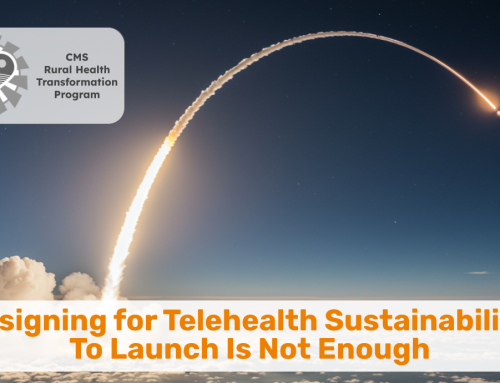Lawmakers Extend Telehealth — But Where’s the Permanence?
This holiday season 2024, lawmakers delivered what many in the healthcare community see as a gift: a temporary extension of telehealth flexibilities through March 2025. For many patients, especially in rural areas these policies have been a lifeline, enabling care to continue across geographic and socio-economic barriers.
Yet, as we celebrate this reprieve, a deeper issue remains unaddressed: why are we still relying on extensions instead of permanent solutions?
While the extensions prevent immediate disruption, their impermanence highlights a recurring problem in healthcare policymaking. Kicking the can down the road may be a favorite sport in DC, but that’s like to keep on walking on crutches and defer the curing surgery.
Regulatory uncertainty surrounding telehealth doesn’t just create headaches for patients, clinicians, and healthcare leaders. This behavior actually actively stifles innovation, prevents strategic investments, and continues to weaken the healthcare system in profound ways.
Exhibit A: Medicare Telehealth Reimbursement
In 2001, during the birth of telehealth reimbursement rules for Medicare beneficiaries, some government accountability bureaucrats got scared: What if payment for telehealth would open the flood gates to utilization? What if everybody who needed care could access it just by the push of a button? Medicare would surely be bankrupt in months.
So their pointy-haired manager (I imagine), in his wisdom decided: “Let them come into a clinic to receive the wonderful treatment of telehealth and let them be living in rural areas only”. When one of his subordinates (maybe his name started with “D”?) asked, “Do we know what rural is?” the manager scoffed and said: “We do not need to know, because these other talented people do.” and thus the designation of “rural” was tied to a definition of rurality determined by a counties’ proximity to larger cities.
Fast forward to Spring 2020, and these nonsense limitations (13 years after the introduction of the iPhone) were finally abolished…temporarily. And still in 2024 we find ourselves not with those “exceptions” made permanent, but merely temporarily extended.
And this is just one example of ill-advised, antiquated legislation that should be recalled. You can read about all the other “extended” provisions in numerous press releases or LinkedIn posts.
But you don’t need another article explaining those extensions. No, in this Holiday edition of Telehealth Tuesday, I want to focus on the downside of the “kicking the can down the road” game.
Regulatory Uncertainty Stifles Innovation
To solve the health problems our society is facing, healthcare must rely on innovation, but innovation requires at least some predictability in this already volatile world. Startups and established telehealth companies alike hesitate to develop new solutions when the rules governing their use are constantly in flux. Why invest in cutting-edge artificial intelligence tools, advanced remote monitoring devices, or specialized telehealth platforms if their reimbursement or compliance pathways could evaporate within months?
Without clarity on a long-term commitment from lawmakers, companies can’t justify the significant resources required for research and development. This hesitancy ultimately slows the pace of progress in telehealth and limits the options available to patients and providers.
Investors and Innovators are wickedly smart. But “hope” that congress will do the right thing is not a strategy, and even now, in this temporary 3-month-only extension, some provisions that were in the original bill were not included.



Strategic Investments Are Put on Hold
The lack of permanence also creates barriers for healthcare organizations planning their long-term strategies. Health systems are reluctant to invest in critical telehealth infrastructure — like advanced software platforms, training programs, and broadband expansions — when the regulatory environment is unpredictable. These investments require years to implement and even longer to yield returns, making the prospect of sudden policy reversals a significant deterrent.
On potential client, a Rural Health Clinic in the Cascade Mountains in Washington, refuses to invest in telehealth, out of concern that reimbursement for Rural Health Clinics will, some day, no longer be there. The fear of uncertainty clearly stifles this leader’s ability to embrace telehealth to benefit their patients
A permanent policy framework would enable healthcare organizations to make bold, strategic investments in telehealth process improvements and support resources. Instead of planning for contingencies or making short-term fixes, these organizations could focus on scaling their operations and meeting patient needs sustainably.
Clinician Confidence Is Undermined
Temporary extensions also create uncertainty for clinicians. Many rural clinicians are still quite apprehensive about fully embracing telehealth as a viable care delivery option and the absence of permanent legislation serves as a convenient excuse to kick their own can down the road. With this kind of resistance and lack of buy-in, healthcare leaders (or telehealth optimization consultants like us) find it extremely difficult to enroll clinicians into integrating telehealth into their practices — from mastering new technologies to redesigning workflows. The constant possibility that telehealth reimbursements or flexibilities could disappear adds another layer of stress.
This uncertainty also discourages clinicians from fully committing to telehealth as a core part of their practice. Instead of seeing telehealth as an opportunity to innovate and expand care, they’re left wondering whether their efforts will be rendered moot by the next round of policy debates.
Patient Access and Continuity of Care Suffer
For patients, the stakes are even higher. Temporary measures often lead to lapses in access when policies expire or shift abruptly. Vulnerable populations, including rural communities and older adults, are particularly affected by this instability. For many, telehealth is not a convenience — it’s a necessity in the absence of transportation or simply time.
Good health outcomes rely on a continuity of care, which depends on patients being able to use telehealth for routine check-ups, chronic disease management, and behavioral health services. When policies are temporary, the resulting uncertainty erodes this reliability, leaving patients to navigate an unpredictable and fragmented system.
Measurement and Improvement Are Hindered
Short-term extensions also hinder efforts to measure and improve telehealth’s effectiveness. To drive improvement, healthcare systems need consistent, longitudinal data to assess the impact of telehealth on patient outcomes, cost-effectiveness, and satisfaction. But when policies are temporary, data collection efforts become piecemeal, limiting the ability to identify trends or drive quality improvement.
A permanent policy framework would allow healthcare organizations to standardize metrics, analyze outcomes over time, and make data-driven decisions to refine telehealth practices. Without this stability, the full potential of telehealth remains out of reach.
My Wishlist: It’s Time for Permanence
While the extension of telehealth flexibilities is a welcome gift, it’s a temporary solution to a long-term need. By failing to make these policies permanent, lawmakers are leaving patients, providers, and innovators in limbo.
Telehealth has proven its value in expanding access, improving outcomes, and addressing healthcare inequities. But to realize its full potential, it needs a stable foundation. Until lawmakers commit to permanent solutions, the healthcare system will remain hindered by the uncertainty that comes with these fleeting gifts.
This holiday season, let’s resolve to push for a future where telehealth isn’t just extended — but where it’s made a permanent cornerstone of modern healthcare.
Then, maybe, we can start to reimagine a future where Virtual Comes First?
What do you think? Is this extension game the “new normal”? What negative effects have you seen? Comment below or reach out to me to discuss.








To receive articles like these in your Inbox every week, you can subscribe to Christian’s Telehealth Tuesday Newsletter.
Christian Milaster and his team optimize Telehealth Services for health systems and physician practices. Christian is the Founder and President of Ingenium Digital Health Advisors where he and his expert consortium partner with healthcare leaders to enable the delivery of extraordinary care.
Contact Christian by phone or text at 657-464-3648, via email, or video chat.






